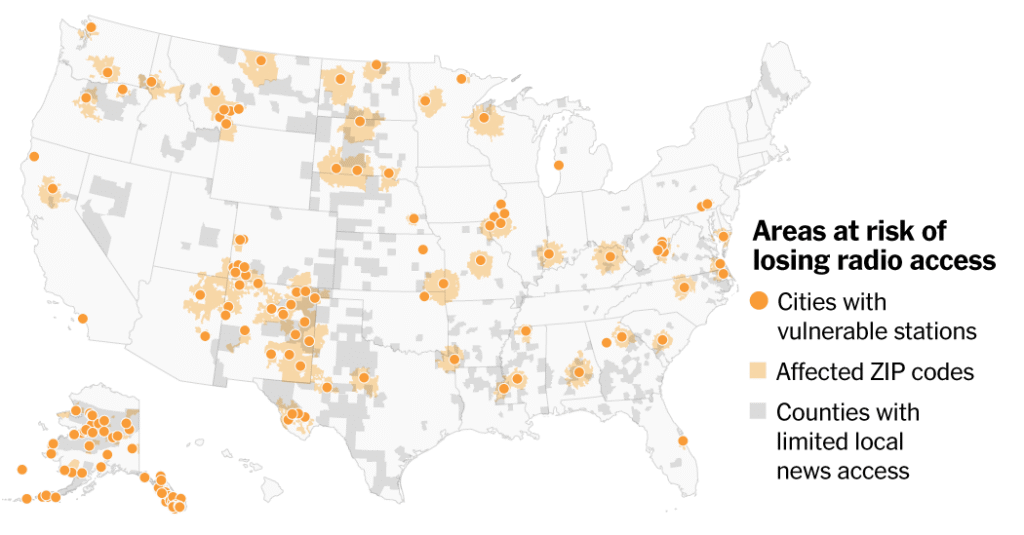President Trump’s proposal to eliminate federal funding for public broadcasters threatens scores of radio and TV stations across the United States that air PBS and NPR programs.
Areas at risk of losing public radio and television access
Early Friday, the House gave final approval to a measure that would eliminate $1.1 billion in funding for the Corporation for Public Broadcasting, the company that funds NPR, PBS and stations in major cities and far-flung towns like Unalakleet, Alaska, and Pendleton, Ore. The measure will now be sent to President Trump, who has pushed for the cuts, for his signature.
The cuts are a time bomb for the public media system. The Corporation for Public Broadcasting has disbursed funding for stations through September. After that, more than 100 combined TV and radio stations that serve millions of Americans in rural pockets of the country will be at risk of going dark, according to an analysis from Public Media Company, an advisory firm.
But the troubles could run deeper than that, said Tim Isgitt, the organization’s chief executive. The sudden and dramatic reduction in funding will result in a pool of fewer stations to buy programming and solicit donations, potentially creating a “doom loop” with dire consequences for the rest of the system.
“Failing stations will create a cascade effect in this highly connected and interdependent system, impacting content producers and leading to the potential collapse of additional distressed stations in other areas of the country,” Mr. Isgitt said.
An analysis by Public Media Company identified 78 public radio organizations and 37 TV organizations that were at risk of going dark as a result of the cuts. In some cases those organizations operate multiple stations, allowing them to reach even greater populations.
The stations rely on grants from the Corporation for Public Broadcasting and other federal funding for at least 30 percent of their budgets, and some of them serve counties with limited access to local news.
Republicans have been trying to defund public media for decades, arguing that news coverage on NPR has a liberal bias and that taxpayers should not be required to support coverage they disagree with. Those attempts have repeatedly failed, with lawmakers unwilling to choke off funding to local stations that serve their constituents.
This week was different. In a Senate vote that mostly broke down along party lines, Republicans clawed back funding from public media organizations in their own states, with some exceptions.
In some states with stations at risk of going dark, such as Mississippi, both senators voted to defund public media. But there was some Republican support in some of the most-affected states, such as Alaska, where Sen. Lisa Murkowski cast a “no” vote, and Maine, where Sen. Susan Collins also opposed the measure. In those states, the combined federal funding for the stations as a proportion of their total budgets is relatively high.
The average proportion of station funding from federal sources, by state
States are grouped by how many of their senators voted to approve the funding clawbacks.
States where both senators voted to defund
| Avg. across TV stations |
Avg. across radio stations |
|
|---|---|---|
| Miss. | 18% | 30% |
| Kan. | 32% | 12% |
| Wyo. | 34% | 10% |
| Ark. | 27% | 15% |
| S.D. | 20% | 22% |
| Tenn. | 32% | 8% |
| Idaho | 18% | 19% |
| Ind. | 26% | 11% |
| N.D. | 16% | 15% |
| Neb. | 19% | 10% |
| W.Va. | 19% | 10% |
| Mont. | 9% | 19% |
| Texas | 20% | 8% |
| Mo. | 18% | 9% |
| Ohio | 20% | 6% |
| Ala. | 12% | 13% |
| N.C. | 14% | 10% |
| Okla. | 14% | 10% |
| Utah | 12% | 11% |
| Ky. | 11% | 11% |
| Iowa | 11% | 10% |
| La. | 12% | 9% |
| Fla. | 12% | 8% |
| S.C. | 13% | 6% |
One senator voted to defund
TV stations |
Radio stations |
|
|---|---|---|
| Alaska | 41% | 31% |
| Pa. | 14% | 6% |
| Wis. | 11% | 5% |
No senators voted to defund
TV stations |
Radio stations |
|
|---|---|---|
| Maine | 35% | 22% |
| N.M. | 24% | 29% |
| Md. | 23% | 11% |
| Mich. | 21% | 8% |
| Minn. | 24% | 4% |
| N.H. | 22% | 6% |
| Va. | 18% | 8% |
| R.I. | 6% | 19% |
| N.J. | 10% | 14% |
| Ariz. | 11% | 12% |
| Ill. | 16% | 7% |
| Ore. | 14% | 8% |
| Ga. | 14% | 7% |
| Colo. | 12% | 7% |
| Hawaii | 14% | 5% |
| N.Y. | 14% | 5% |
| Calif. | 12% | 6% |
| Vt. | 12% | 6% |
| Wash. | 11% | 7% |
| Conn. | 7% | 6% |
| Nev. | 6% | 7% |
| Mass. | 8% | 4% |
| Del. | — | 10% |
The at-risk stations have a few months to figure out how to make up their financial shortfalls. Public Media Company has begun to speak with philanthropists and foundations about possible solutions.

